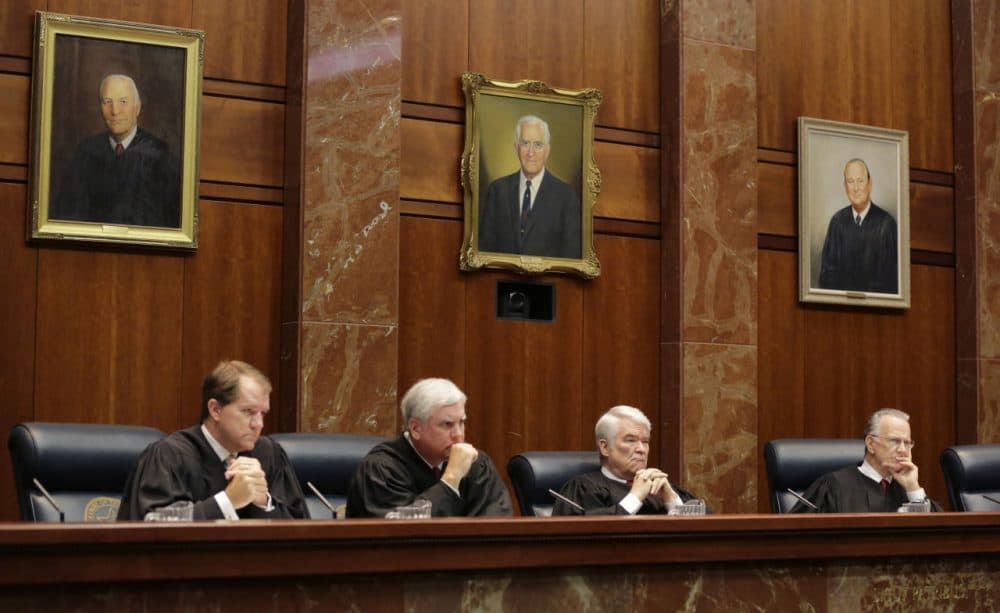Advertisement
Texas Teenagers Join Fight For More School Funding
Resume
The Texas state educational system is under review by the state Supreme Court again. More than 600 schools are suing the state of Texas and its lawmakers for what they say is an unconstitutionally underfunded school system. The courts have agreed twice with the schools, but Texas Governor Greg Abbot and other legislators say this isn't a decision to be made by judges.
A group of Texas teenagers has now filed a 35-page amicus brief with the Texas Supreme Court, in favor of more funding for schools. College freshman Zaakir Tameez is one of the creators of the Houston Independent School District (HISD) Student Congress and co-authored the brief. He speaks with Here & Now's Peter O'Dowd.
Interview Highlights
How did this all get started?
“A few months ago in April, we took 100 students to Austin, and we lobbied for a school finance bill which would have restored the funding that Texas has been consistently cutting for the past few years. And the bill failed, and it is part of a national trend where we go to our politicians and nothing happens. So we found this lawsuit the Supreme Court was looking at so we said, ‘why don’t we turn to the courts, why don’t we see if they might help us out.’”
What was life like in your own Houston high school?
“My high school was one of the better ones, it was a magnet school, so we had students from everywhere who were getting an education that you can’t find in many places. But everyone came from different backgrounds and it was a free public school, so everyone came from different middle schools and different neighborhoods. And it kind of opened your eyes to the wealth of experiences that are out there. My school district, HISD, is the largest in Texas, seventh-largest in America, and it’s over 80 percent below poverty line, and there’s so many different schools out there and everybody has a different experience, and that’s just not right.”
What are the differences between your educational experience and someone at a less fortunate school?
“In the brief, we mentioned four issues that we think need to be talked about. The first is class sizes, so schools will have kids crammed into the building and it’s hard to get an education if there’s 50 people in your classroom. The second thing we talk about is enrichment programs, so arts education, music, P.E. We mention in our brief that a lot of kids don’t come to school to learn math sometimes, we come to go to orchestra, but you know, if math is there we’ll learn it too. The third thing we talk about is teacher quality. We need funding to improve teacher certification to get teachers trained to teach us. And the fourth thing we talk about is college and career readiness. A lot of schools lack the number of counselors they need for students to apply to college, they lack the resources and the advice on what careers to approach and what vocational schooling is out there. So these are four major issues that we need to face in Texas, because we just lack the access.”
Do you think people graduate high school in Houston without knowing how to speak English well?
“I think there’s a lot of people who manage to get by, and just get by, and then they graduate and find out they are completely not ready for college if they go there, or not ready for a vocational school if they show up there. A lot of people talk about high school graduation rates, but another thing to look at is college readiness rates, or career readiness rates, if you graduate high school and then you find out you were misprepared in high school.”
Why would more money solve the problem?
“A lot of people say that money isn’t the problem, that you can’t just throw money into education. And that’s true but money can do a lot of things. The question lingering in a lot of people’s heads is ‘what would more funding do?’ Because, it seems like we intuitively know that funding would help but the question is why. So we say that if you have more funding, you could have more teachers and therefore smaller class sizes. If you have more funding, you can have more arts programs and therefore more enrichment. If you have more funding, you can get more teachers certified and therefore have better teacher quality. If you have more money, you can pay the salary for more counselors and have better college and career readiness programs. The money really does help.”
Isn’t it more about how you manage money?
“It’s a good point about allocation of the money, but that’s not the question the court is considering. The court is considering that right now, right here, a lot of students in Texas aren’t reading at grade level, they’re not prepared for the work force, they're failing the state exam. So now we can ask these other questions, but right now the question facing the court is are students getting an adequate education, and they’re not. So for the brief, we left a lot to the lawyers, and we left the school finance stats to the financial people and we just said, ‘this is the quality of our education right now, this is what money can do, and we’re just going to tell you, because we need help right now, and this is why.’”
Guests
- Zaakir Tameez, freshman at the University of Virginia and one of the creators of the HISD Student Congress. He tweets @ztameez.
This segment aired on September 17, 2015.